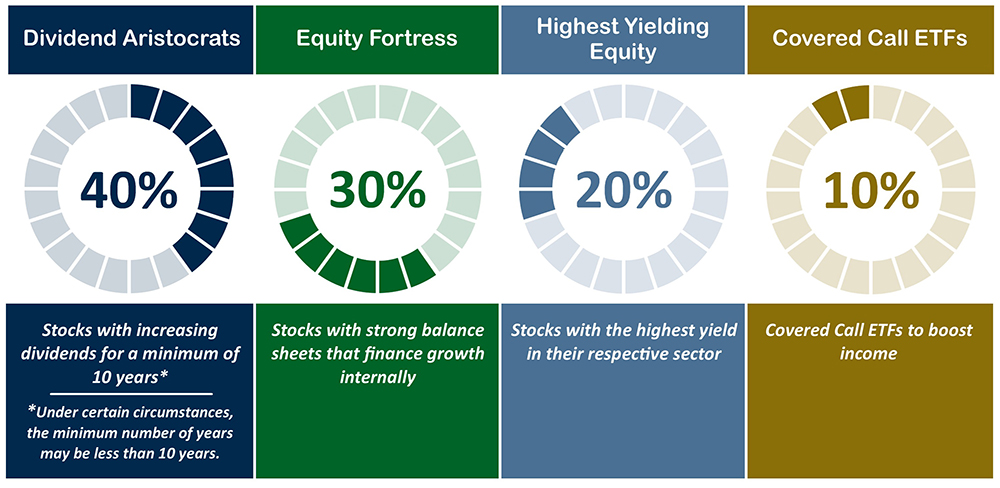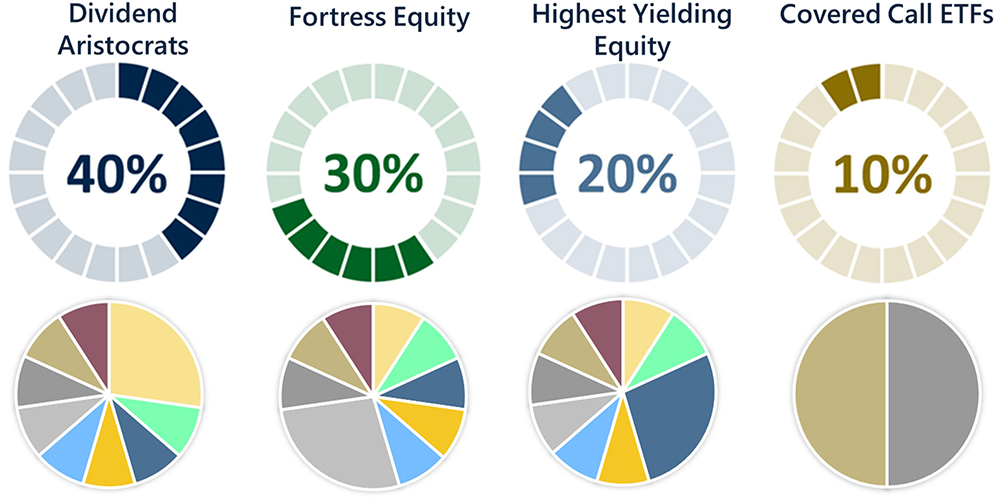With today's market uncertainty, investors are looking for market exposure in a risk managed way. We must search for investment themes that may provide better capital protection during periods of market volatility while still providing attractive long-term performance and superior income generation. Investors owe it to themselves to not follow the herd and instead look for unique investment concepts based on historically sound principles.
Strategy Description:
A fully invested, risk managed equity income strategy that focuses on high quality, mid-to-large-cap companies.

Final Strategy and Sector Allocation

Quarterly Reallocation & Rebalancing
Not an offer of Portfolio Shares.
Investments are subject to risk; loss of capital is possible.
You should carefully consider the investment objectives, risks, and charges and expenses before investing. Each investor's situation is unique so please work with a professional financial adviser, tax accountant or legal representative, as applicable, to develop an individualized plan or address any questions you may have. Additional information is available upon request.
Definitions:
The S&P 500 includes 500 leading companies in leading industries of the US economy and is a proxy for the total stock market.
The Global Industry Classification Standard (GICS) is an industry taxonomy developed in 1999 by MSCI and Standard & Poor's (S&P) for use by the global financial community. The primary 11 GICS Sectors are Energy, Materials, Industrials, Utilities, Health Care, Financials, Consumer Discretionary, Consumer Staples, Information Technology, Communication Services, and Real Estate.
Energy Sector The Energy Sector comprises companies engaged in exploration & production, refining & marketing, and storage & transportation of oil & gas and coal & consumable fuels. It also includes companies that offer oil & gas equipment and services.
Materials Sector The Materials Sector includes companies that manufacture chemicals, construction materials, forest products, glass, paper and related packaging products, and metals, minerals and mining companies, including producers of steel.
Industrials Sector The Industrials Sector includes manufacturers and distributors of capital goods such as aerospace & defense, building products, electrical equipment and machinery and companies that offer construction & engineering services. It also includes providers of commercial & professional services including printing, environmental and facilities services, office services & supplies, security & alarm services, human resource & employment services, research & consulting services. It also includes companies that provide transportation services.
Consumer Discretionary Sector The Consumer Discretionary Sector encompasses those businesses that tend to be the most sensitive to economic cycles. Its manufacturing segment includes automobiles & components, household durable goods, leisure products and textiles & apparel. The services segment includes hotels, restaurants, and other leisure facilities. It also includes distributors and retailers of consumer discretionary products.
Consumer Staples Sector The Consumer Staples Sector comprises companies whose businesses are less sensitive to economic cycles. It includes manufacturers and distributors of food, beverages and tobacco and producers of non-durable household goods and personal products. It also includes distributors and retailers of consumer staples products including food & drug retailing companies.
Health Care Sector The Health Care Sector includes health care providers & services, companies that manufacture and distribute health care equipment & supplies, and health care technology companies. It also includes companies involved in the research, development, production and marketing of pharmaceuticals and biotechnology products.
Financials Sector The Financials Sector contains companies engaged in banking, financial services, consumer finance, capital markets and insurance activities. It also includes Financial Exchanges & Data and Mortgage REITs.
Information Technology Sector The Information Technology Sector comprises companies that offer software and information technology services, manufacturers and distributors of technology hardware & equipment such as communications equipment, cellular phones, computers & peripherals, electronic equipment and related instruments, and semiconductors and related equipment & materials.
Communication Services Sector The Communication Services Sector includes companies that facilitate communication and offer related content and information through various mediums. It includes telecom and media & entertainment companies including producers of interactive gaming products and companies engaged in content and information creation or distribution through proprietary platforms.
Utilities Sector The Utilities Sector comprises utility companies such as electric, gas and water utilities. It also includes independent power producers & energy traders and companies that engage in generation and distribution of electricity using renewable sources.
Real Estate Sector The Real Estate Sector contains companies engaged in real estate development and operation. It also includes companies offering real estate related services and Equity Real Estate Investment Trusts (REITs).
Dividend Aristocrats is a BTS strategy that breaks the S&P 1500 into its 11 GICS Sectors and then filters all securities that have 10-15 years of increasing dividends, based on which sector it is in. BTS may consider a security with less than 10 years of increasing dividends if there are less than 2 securities in any given sector with less than 10 years of increasing dividends. These securities are then run through a proprietary securities selection algorithm that is rule-based in nature and does not change. The top security is then compared against similar historical Dividend Aristocrats in its sector and a historical outperformance is calculated. The top sector is overweighted, and the bottom 2 sectors are eliminated.
Equity Fortress is a BTS strategy that breaks the S&P 1500 into its 11 GICS Sectors and then filters the top 5-10 securities in each sector based on a proprietary Equity Fortress Model that considers how well the security can finance internal revenue and asset growth without taking on excess debt. These securities are then run through a proprietary securities selection algorithm that is rule-based in nature and does not change. The top security is then compared against similar historical Equity Fortress securities in its sector and a historical outperformance is calculated. The top sector is overweighted, and the bottom 2 sectors are eliminated.
Highest Yielding Equity is a BTS strategy that breaks the S&P 1500 into its 11 GICS Sectors and then filters the top 5-10 securities in each sector based on highest Dividend Yield. These securities are then run through a proprietary securities selection algorithm that is rule-based in nature and does not change. The top security is then compared against similar historical Highest Yielding Equity securities in its sector and a historical outperformance is calculated. The top sector is overweighted, and the bottom 2 sectors are eliminated.
Covered Call refers to a financial transaction in which the investor selling call options owns an equivalent amount of the underlying security. To execute this, an investor who holds a long position in an asset then writes (sells) call options on the same asset to generate an income stream. The investor's long position in the asset is the cover because it means the seller can deliver the shares if the buyer of the call option chooses to exercise.
Market Capitalization refers to the total dollar market value of a company's outstanding shares of stock.
Fundamental Ratios are quantitative measures that are used to assess businesses.
Internal Growth Rate (IGR) is the highest level achievable for a business without obtaining outside financing, and a firm's maximum internal growth rate is the level of business operations that can continue to fund and grow the company.
Out Of The Money (OTM) Call Option is an expression used to describe an option contract that only contains extrinsic value. These options will have a delta of less than 0.50. An OTM call option will have a strike price that is higher than the market price of the underlying asset.
Option Premium is the current market price of an option contract. It is thus the income received by the seller (writer) of an option contract to another party.
BTS Asset Management, Inc. ("BTS") is an investment adviser registered with the SEC. BTS' website is limited to the dissemination of general information regarding BTS' investment advisory services. The information on this website is for general informational purposes only and should not be construed by any prospective or existing client of BTS as a solicitation to effect transactions in securities. In addition, the information on this website should not be construed by any prospective or existing client as personalized investment advice. BTS’ investment advice is given only within the context of its contractual agreements with each client. BTS' investment advice may only be rendered after the delivery of its Form ADV Part 2 and the execution of an agreement by the client or investor. BTS' Form ADV Part 2 describes BTS' business operations, services and fees and is available upon request. All information contained on this website is subject to change without notice. The information contained on this website may include forward looking statements which are based on BTS' current opinions, expectations and projections. BTS does not have any obligation to update or revise any forward looking statements. Actual results could differ materially from those anticipated in the forward looking statements. Past performance is no guarantee of future results.